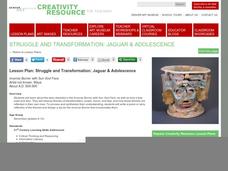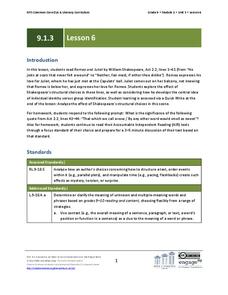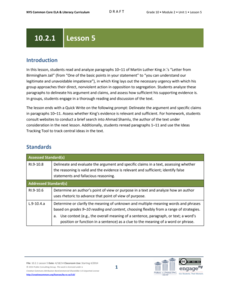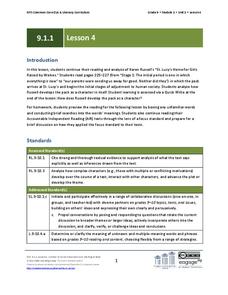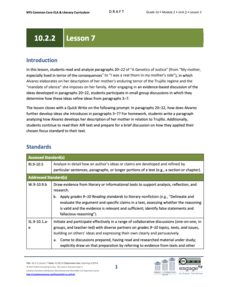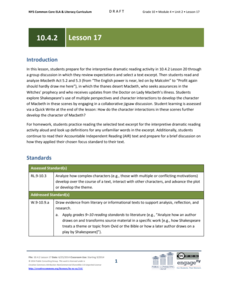Curated OER
Lesson: Urs Fischer: Your Choice: Reality or Illusion?
Young analysts write a comparative essay, but about what? They compose a paper based on several critical discussion about reality and illusion, and how both are blurred in art. They analyze several theatre pieces that exemplify Brechtian...
Curated OER
Lesson Plan: Sensory Exploration
Using their keen eyes and ears, learners build story observation skills which they will use to create sensory detail in their art. They note all of the things they observed on a walk, categorize them by sense, and then use the same skill...
Curated OER
Lesson: Struggle and Transformation: Jaguar & Adolescence
To break down complex themes, discuss a sense of self, and learn a bit about Mayan culture, learners start through art analysis. They analyze a Mayan incense burner, discuss themes, and then write a short story that includes themes from...
Curated OER
Lesson: While You Were Sleeping....
Imagine you are a bug living on a leaf in the painting, Bouquet of Flowers in a Vase by Maria van Oosterwyck. This is what you'll tell your class as they analyze the lovely image. They list details in the painting, find two insects...
EngageNY
Grade 9 ELA Module 1, Unit 1, Lesson 1
Word choice can drastically alter the tone of a piece of writing. Ninth graders read Karen Russell's short story "St. Lucy's Home for Girls Raised by Wolves" and use textual evidence to help them analyze how word choice affects their...
EngageNY
Grade 10 ELA Module 1: Unit 1, Lesson 7
Can three works of literature work together to establish and develop a common central idea? Put your thoughts into writing with a final assessment focused on a unit-long analysis of Christopher Marlowe's "The Passionate Shepard to His...
EngageNY
Grade 9 ELA Module 1: Unit 3, Lesson 6
The balcony scene from Romeo and Juliet takes center stage as class members consider the structural choices Shakespeare makes, i.e., having Romeo appear first in the scene and having Juliet appear unaware that Romeo is listening to her...
EngageNY
Grade 10 ELA Module 2: Unit 1, Lesson 5
People should always choose their words carefully. Scholars examine the words used by Martin Luther King, Jr. in paragraphs 10 and 11 of his "Letter from Birmingham Jail." Readers answer questions about word use, think about synonyms,...
EngageNY
Grade 10 ELA Module 4: Unit 2, Lesson 5
When Macbeth says, "Nature seems dead," he uses personification. Using the resource, scholars complete a Quick Write to analyze the impact of figurative language on the mood of Shakespeare's Macbeth. Pupils also participate in an...
Curated OER
Lesson: Heroes: Then and Now
What is the difference between Hercules and Spiderman? Both are heroes, right? Kids identify the characteristics that make a hero, and analyze the differences between heroes of long ago and today. They write creative stories describing a...
EngageNY
Grade 9 ELA Module 1, Unit 1, Lesson 4
Connect with the text using helpful annotation strategies. As your class reads the first section of Karen Russell's short story, "St. Lucy's Home for Girls Raised by Wolves," they note important passages that establish character...
Curated OER
Lesson: Jazzy Stripes and Worlds
Every artist creates in his own unique way drawing from a variety of inspirational sources. Upper graders work to expand their understanding of the creative process by first analyzing a modern piece and then creating one. They listen to...
Curated OER
Lesson: Stepping into the Past
How have things changed from the past until now? Young art historians examine a screen painted in Mexico during the 1700s. They discuss the differences between a garden party then and now. They then write a journal entry about the party...
Curated OER
Lesson Plan: What We Value
How have values changed? How does our society influence our choices? Two great questions lead this discussion about food production, history, and cause-and-effect relationships. Pupils analyze a limestone relief from Assyria, research...
Curated OER
Lesson: All in the Family
Who was the Radcliffe family? Young learners find out about the life and times of a family from long ago. They analyze the family portrait, write a story about the family, and then use their story to create thought or word bubbles which...
Curated OER
Lesson: From the Horse's Mouth
Kids turn a critical eye on a wooden horse that was carved in ancient China. They analyze the horse as far as its purpose, historical significance, and artistic style, then write a story from the horse's perspective.
Curated OER
Lesson: A Collage of Cultures
The blanket being analyzed here seems simple and plain, but it reflects the culture and geography of the people who made it. Learners critically examine the influence geography and culture had on the creation of the blanket and on...
Curated OER
lesson: Facing a Stone Situation
Can you imagine what it's like to be able to carve an animal out of stone? Kids do, as they analyze the techniques used to create the South Indian sculpture, Sacred Bull of Shiva. After a critical look at the piece, they write a...
EngageNY
Grade 9 ELA Module 2, Unit 2, Lesson 10
The slow curse of realization begins to sink in during the tenth instructional activity in a literary analysis unit on Sophocles' Oedipus the King. Ninth graders carefully read the selected lines for evidence of Oedipus' feelings during...
EngageNY
Grade 10 ELA Module 2: Unit 1, Lesson 17
Scholars read the final paragraphs written by Martin Luther King Jr. in "Letter from Birmingham Jail." Readers work in groups to discuss King's word choice and point of view by completing graphic organizers. They also respond to a...
EngageNY
Grade 10 ELA Module 2: Unit 2, Lesson 7
"No flies fly into a closed mouth." Pupils consider the proverb's meaning as they read paragraphs 20–22 from the essay "A Genetics of Justice" by Julia Alvarez. They also engage in small-group discussions about how the author refines her...
EngageNY
Grade 10 ELA Module 2: Unit 2, Lesson 8
How do people's relationships with their parents impact their lives? Scholars read paragraphs 23–26 from "A Genetics of Justice" by Julia Alvarez, in which the author details her relationship with her mother. Pupils discuss how the...
EngageNY
Grade 10 ELA Module 4: Unit 3, Lesson 3
What's the difference between men and princes? Machiavelli discusses this distinction in chapter 18 of The Prince. Scholars first listen to a masterful reading of the chapter. Then, they write about how the author develops a central idea...
EngageNY
Grade 10 ELA Module 4: Unit 2, Lesson 17
Madness, violence, despair—the titular character of Shakespeare's Macbeth is spiraling out of control. Pupils first explore the topic with a collaborative jigsaw discussion. At the end of the instructional activity, they write about how...
Other popular searches
- Thanksgiving Writing Lessons
- Expository Writing Lessons
- Descriptive Writing Lessons
- Creative Writing Lessons
- Persuasive Writing Lessons
- Essay Writing Lessons
- Paragraph Writing Lessons
- Interactive Writing Lessons
- Explanatory Writing Lessons
- Informative Writing Lessons
- Halloween Writing Lessons
- Free Esl Lessons Writing


